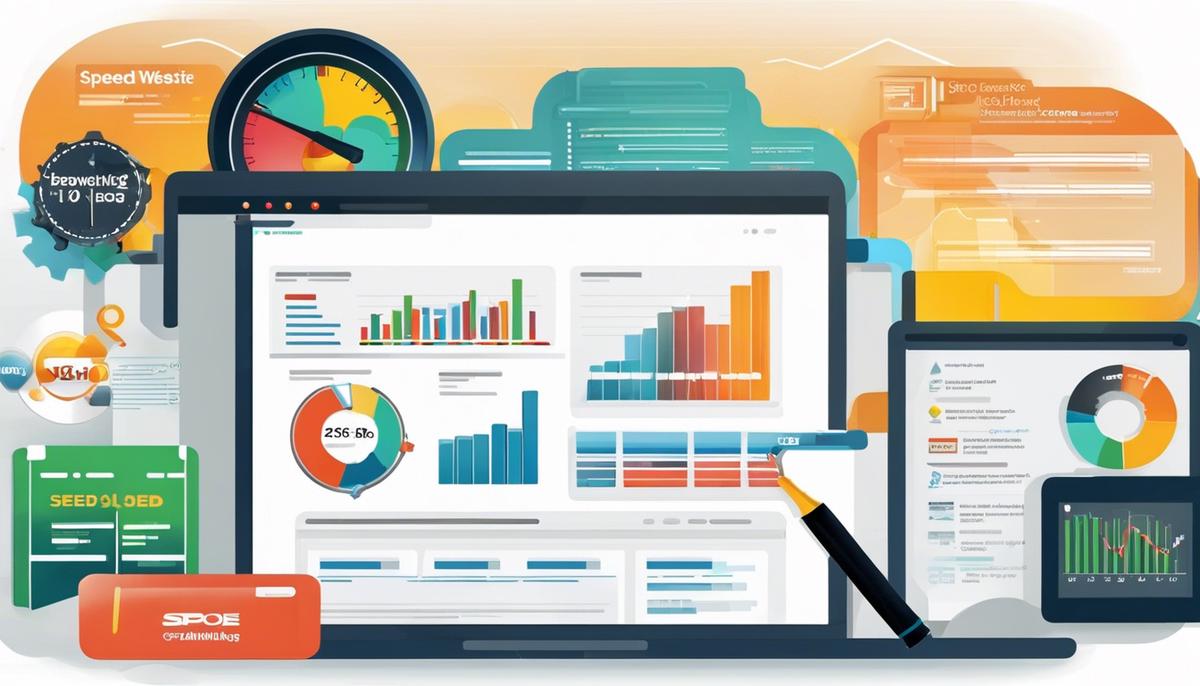In the digital age, how swiftly a website loads can significantly impact its visibility and success online. This connection between website speed and search engine optimization (SEO) isn’t just a thought, but a tangible behavior that major search engines like Google incorporate into their ranking algorithms. A site’s speed is now more critical than ever in its SEO strategy, as it influences user engagement, user experience, and website traffic. This essay delves into the multi-layered relationship between website speed and SEO, the importance of identifying lagging elements hurting the load times, and the methods available for testing a website’s speed.
Understanding Website Speed and SEO
It’s no secret that website optimization is a must for any business hoping to stand out in the vast digital landscape. Among the multitude of elements to consider, website speed stands prominently as an influential factor in the success of Search Engine Optimization (SEO) efforts. Let’s delve into why that is.
Search engines like Google unequivocally prioritize user experience over everything else. And what does a slow website signify? Yes, you guessed it, a poor user experience. The quicker a website loads, the better it is perceived by the user, making it more likely that they will stick around and explore further.
To put it in perspective, research revealed that 53% of mobile users will abandon a site that takes more than three seconds to load. Not only does this increase the bounce rate but it also directly impacts the conversion rate.
Google’s algorithm considers page speed as a ranking factor in both mobile and desktop searches. A website with fast loading speeds implies a user-friendly experience, thereby having a positive effect on its overall SEO ranking.
But wait, there’s more. A smoothly operating, speed-optimized website also allows search engine spiders to crawl more pages using their allocated crawl budget. This increases the likelihood of more pages being indexed swiftly, improving the site’s visibility in search engine results.
So, how to ensure top-notch website speed? Several strategies can be implemented to boost the load speed of a website. Using fast hosting, optimizing images and videos, leveraging browser caching, and minifying CSS, JavaScript, and HTML are some of the common ways to enhance website speed.
Investing in a Content Delivery Network (CDN) can also pave the way for speedy website load times. CDNs distribute the load of delivering content efficiently, ensuring quick load times worldwide, contributing to an improved SEO ranking globally.
In conclusion, website speed is a non-negotiable aspect of SEO success. It ensures a positive user experience, reduces bounce rates, improves conversion rates, and increases the number of indexed pages – all contributing to an improved position in search engine results. Therefore, investing time and resources into optimizing website speed should be a primary focus in any firm’s digital strategy.

Identifying Speed Issues
Identifying Speed Issues on Your Website: A Tactical Guide
In the riveting landscape of digitization, it’s now more important than ever to ensure the seamless operation of your website. After understanding the fundamental importance of website speed and its influence on search engine optimization (SEO), one might potentiate a question: how can I pinpoint speed problems on my website? Fortunately, this is an entirely solvable issue with the proper tools and strategy.
The first line of action in identifying speed issues is leveraging speed test tools. These present a convenient, systematic approach to pinpointing and resolving inefficiencies. Popular options include Google PageSpeed Insights, GTMetrix, and Pingdom. These tools provide a holistic analysis of your webpage’s speed and performance across various parameters, pinpointing any elements that could be causing slowdowns.
Consider the use of waterfall analysis, which is an interactive breakdown of each asset’s loading time on your webpage. It allows you to observe the complete picture of your website’s loading process, tracking each request’s trajectory. This strategy is particularly powerful as it pinpoints which files or media are responsible for slowdowns.
A thorough audit of your Javascript and CSS files is also pivotal. Free tools like Google’s Lighthouse and Chrome DevTools can provide an in-depth analysis of how your scripts affect page loading speed and performance. Track how your scripts are affecting your total blocking time (TBT) — a crucial metric measuring the total amount of non-interactive time while the page is loading.
Monitoring server response times should also be an integral part of your strategy. This checks the speed of your web server and is crucial since server delays invariably affect page load times. Tools like Dynatrace or Datadog can help in this monitoring process, thus facilitating prompt problem-solving. Likewise, regularly checking on redirects and DNS lookups aids in ensuring these do not cause unnecessary delays.
Another point of focus is your website’s mobile speed. With the ascendancy of mobile searches, ensuring your webpage loads swiftly on mobile devices is not just strategic but intensely practical. With Google’s “Mobile-First Indexing,” your mobile website speed directly influences search engine rankings. Test your mobile loading times using tools such as Test My Site or Mobile-Friendly Test from Google.
A website speed test is not a one-time task. Regular testing is essential to maintain an optimal user experience and secure high SEO rankings. By routinely running speed tests, you can proactively identify any emerging issues and rectify them before they start impacting your website’s performance or visitor satisfaction.
As with any technology-centric issue, staying ahead of problems is key. Speed issues on your website are both diagnosable and treatable. With the right knowledge, the correct tools, and a bit of patience, rest assured that speed-related challenges can be addressed effectively, ensuring your website performs at its optimum capacity.

Implementing Speed Optimization Techniques
Building upon the key elements that have been previously discussed, there are more advanced technical methods that can be employed to further enhance your website’s speed.
Understanding HTTP/2: Shifting from the traditional HTTP/1.1 to HTTP/2 can contribute significantly towards reducing loading times. Due to features like multiplexing and server push, HTTP/2 can efficiently carry out multiple requests simultaneously between the client and the server.
Removal of unnecessary plugins: Over the years, the website might have become bloated with unnecessary plugins. These plugins can drastically slow down your website as they add extra HTTP requests, JavaScript, and CSS loads. Regular audits to identify and remove such plugins can help maintain a clean, speed-optimized website.
Implementation of load balancing: Load balancing techniques distribute incoming network traffic across multiple servers, increasing the efficiency and reliability of your website, thereby reducing the overall load times. Solutions like Nginx and HAProxy can be considered to aid load balancing efforts.
Compression techniques: Techniques like Gzip compression can effectively reduce the size of the transferred response data by up to 90%. It’s widely supported by modern browsers and server-side technologies, enabling faster loading times.
Reducing third-party scripts: Third-party scripts, while often essential for various functionalities, can significantly slow down your website. By reducing the volume of such scripts, especially those that block rendering, you can boost page load speeds.
Accelerated Mobile Pages (AMP): In the era of mobile-first indexing, having AMP can significantly improve the loading times of your website on mobile devices. It’s an open-source project designed to make web content load faster for mobile users.
Lazy Loading: The lazy loading technique ensures images and videos only load when they’re close to or in the user’s viewport. This reduces initial load time and saves bandwidth for both the user and server.
Implementing DNS prefetching: The DNS prefetching technique can significantly boost website speed by resolving domain names before a user tries to follow a link, which can be very helpful, especially for sites with content from multiple domains.
Efficient handling of Cookies: Setting the domain and path directives correctly in the cookies are absolutely critical. Missteps in this area could lead to cookies for one subdomain being sent up with requests to another subdomain thereby wasting the users and servers bandwidth causing unnecessary slow-downs.
Remember, enhancing a website’s speed is not a one-time task but rather an ongoing commitment. As new technologies and trends emerge in the rapidly evolving digital landscape, staying updated and adapting to the ever-changing best practices of website speed optimization will help maintain an edge in the SEO game. After all, in the digital world, even a few seconds can make or break the user experience.

Whether it’s compressing files, cleaning up code, or switching to a superior hosting service, optimizing your website’s speed is a proactive move towards boosting your overall SEO performance. Embracing techniques such as code minification, browser caching, and utilizing a Content Delivery Network (CDN) can greatly enhance your website’s loading speed, which in turn, positively reflects on your website’s SEO. In an online environment fiercely centered on user experience, taking the time to fine-tune website speed isn’t just an option but a necessity for businesses to thrive. Remember that the faster your website loads, the quicker you can engage your audience, leading to higher conversions, improved customer retention, and better visibility in search engine results.






